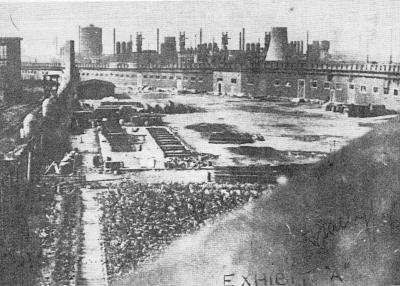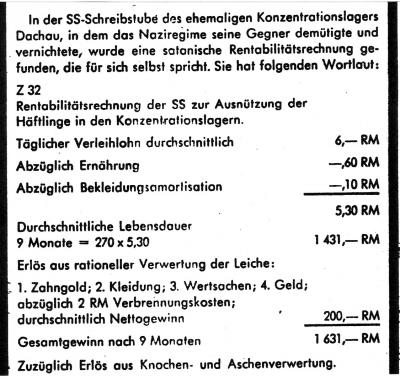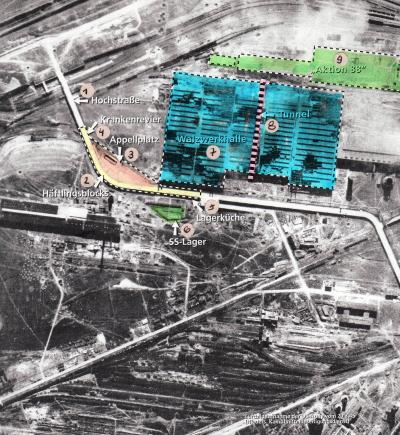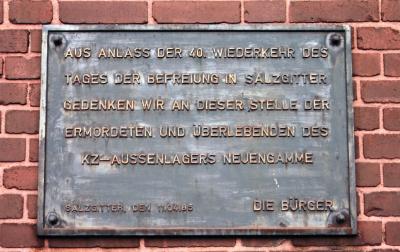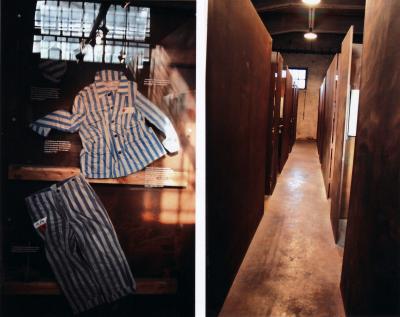Salzgitter Drütte
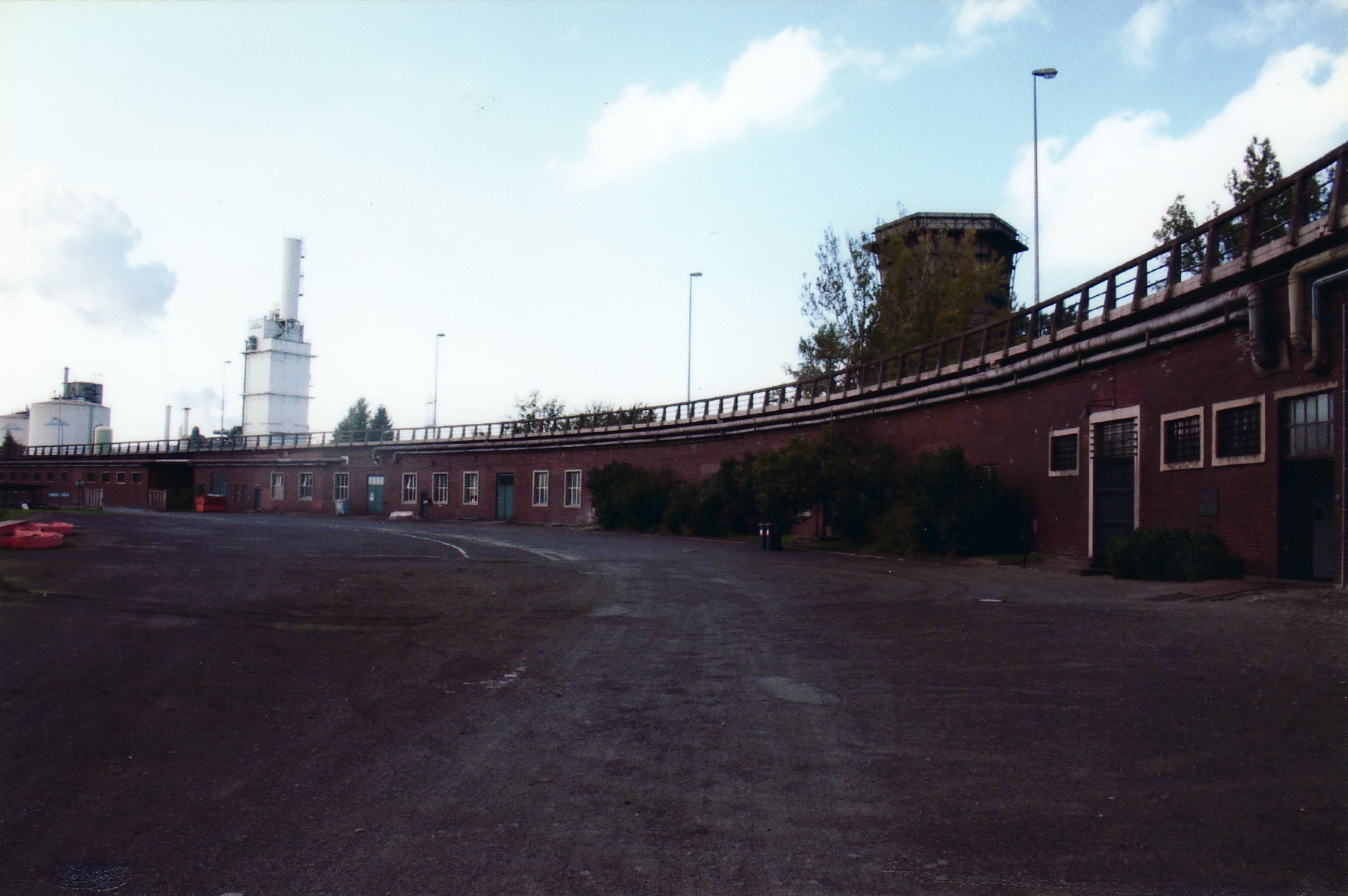
The establishment of "KZ Drütte" as one of the first branches of Neuengamme concentration camp in autumn 1942 was directly related to the extension of Braunschweig steelworks that started producing ammunition already in 1940 and were part of the Reichswerke Hermann Göring conglomerate. The camp was intended for about 3,000 prisoners (males and females) and it was located in the premises of the steelworks. When it was established, some other camps were closed; including camp No. 27 for Polish forced labourers located in the vicinity of the steelworks. Its prisoners were transferred here. Apart from four buildings where forced labourers were crowded in harsh conditions, a camp kitchen and a sick ward, there were four watchtowers built there, nine single shooting bunkers and five wooden barracks in the vicinity for an SS guard unit of 100 people.
The biggest groups of prisoners were Russians, Poles, French and Dutch, but also Jews from Poland, Germany and the Balkan States. By the end of 1943, some Italians also appeared in the camp. They were mainly young people, (still) able to work hard, often caught during roundups carried out in countries occupied by Germans or brought from other camps. Forced labourers were exploited at everyday 12-hour work. In the overcrowded barracks two prisoners had to share a single bunk, food was provided in starvation portions and clothes were not suited for surviving the winter nor for work.
Extremely hard labour, horrendous overall conditions, insufficient nutrition and clothing as well as lack of basic hygiene materials and medications caused conditions that often turned into contagious diseased and epidemics. Moreover, the guards or Kapo beat the prisoners without a reason, for any minor misdemeanour, or in a situation when they dropped exhausted and unable to continue working. There were also cases of shooting a prisoner on his way to work or in the work establishment. "Officially" adjudicated death sentences were also a regular thing. With time, trucks loaded with corpses would more and more often run from the camp to the newly created "Jammertal" cemetery in Salzgitter-Watenstedt or to Braunschweig, where the bodies were burnt in the cemetery crematorium at Helmstedter Straße. In the days before evacuation, SS murdered those prisoners who were unable to march and the bodies were buried even within the premises of the steelworks. The last victims of KZ Drütte were discovered on the 17th of August 1952 during ground works in the premises of the rolling mill, right next to the former camp.
From the 18th of March until the 2nd of April 1947, seven torturers from KZ Drütte stood before the court in Hamburg accused of killing and tormenting the citizens of allied states in the Hermann Göring-Werke facility labour camp. In spite of strong witness testimonies against them, the military court convicted only three of the accused, adjudicating imprisonment for a period incommensurate with the committed crimes - "Rapportführer" Karl Hecht was sentenced to seven years in prison, the first assistant of the facility Walter Mehnert - to five years and an SS member Karl Sokola - to 6 months.
For many years, the issue of war crimes in Salzgitter was a taboo subject and the only evidence of those events were two cemeteries in the town where over 3,800 victims of war and despotism were buried. Only in 1972 Volksbund Deutsche Kriegsgräberfürsorge tidied up the Jammertal cemetery and made it accessible as a memorial site for the victims of Nazism, while in 1982 on the 40th anniversary of establishing the town of Salzgitter the Folk High School (Volkshochschule) and the Evangelical Church organised a successful range of exhibitions and lectures on war events in the town. Some of the elements that contributed to breaking the silence included a publication by Gerda Wysocka, entitled "Zwangsarbeit im Stahlkonzern" (Forced labour in a steel conglomerate) and establishment (in 1983) of "Arbeitskreis Stadtgeschichte e.V." (The town history working group). Since then every year on the 11th of April there are ceremonies commemorating the arrival of the American army in the town and liberation of Drütte concentration camp. After many years of discussions, in January 1992 agreement was reached with regards to the creation of a memorial site within the separated area of the former camp - today this area is owned by Salzgitter AG conglomerate. The memorial plaque from 1985 reads:
ON THE 40TH ANNIVERSARY OF LIBERATION OF SALZGITTER, WE ARE COMMEMORATING THE MURDERED AND LIVING PRISONERS OF A NEUENGAMME CONCENTRATION CAMP BRANCH
Some of the names and information about the deceased and killed forced labourers from Drütte concentration camp is included in the list of victims of the Salzgitter-Jammertal war cemetery.
